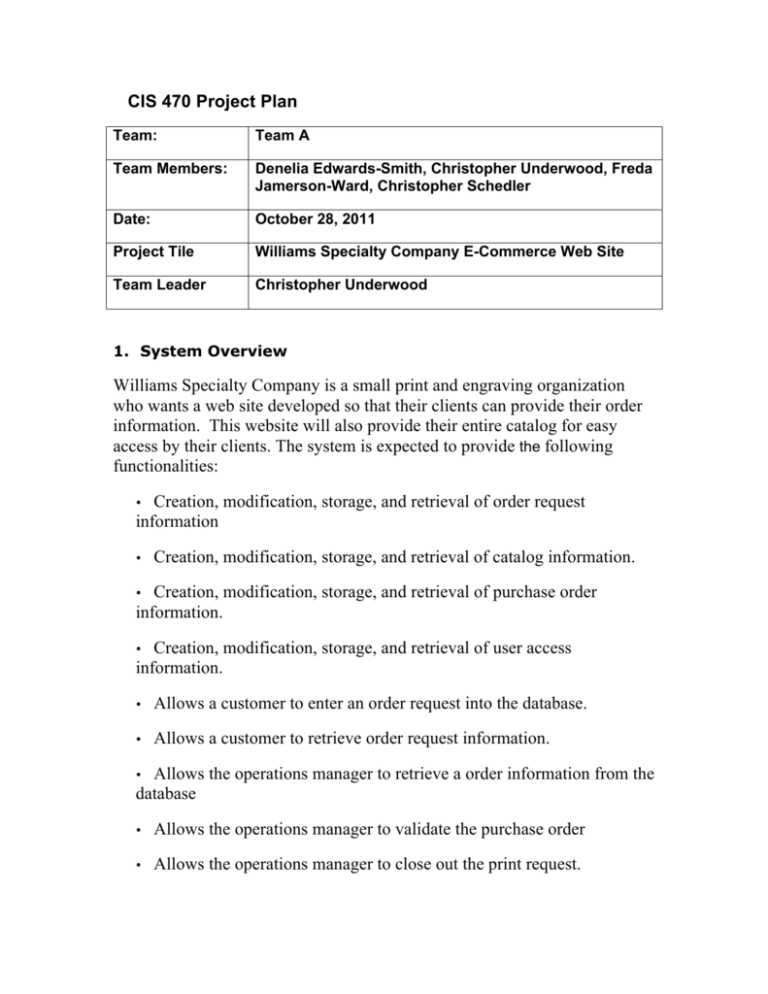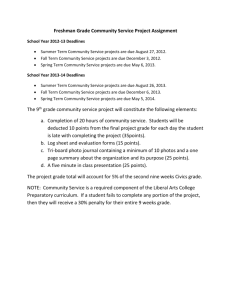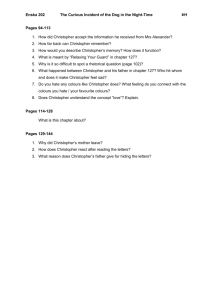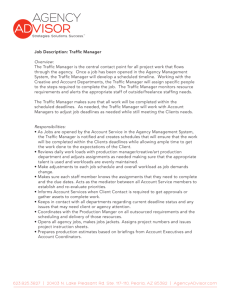CIS 470 Project Plan Williams Specialty Company is a small print
advertisement

CIS 470 Project Plan Team: Team A Team Members: Denelia Edwards-Smith, Christopher Underwood, Freda Jamerson-Ward, Christopher Schedler Date: October 28, 2011 Project Tile Williams Specialty Company E-Commerce Web Site Team Leader Christopher Underwood 1. System Overview Williams Specialty Company is a small print and engraving organization who wants a web site developed so that their clients can provide their order information. This website will also provide their entire catalog for easy access by their clients. The system is expected to provide the following functionalities: Creation, modification, storage, and retrieval of order request information • • Creation, modification, storage, and retrieval of catalog information. Creation, modification, storage, and retrieval of purchase order information. • Creation, modification, storage, and retrieval of user access information. • • Allows a customer to enter an order request into the database. • Allows a customer to retrieve order request information. Allows the operations manager to retrieve a order information from the database • • Allows the operations manager to validate the purchase order • Allows the operations manager to close out the print request. • Allows a customer to update their personal and billing information. 2. Project Development Management The project will be managed through the following phases Planning Requirements Analysis and Design Code Compile and Test • Implementation • • • • • 2.1. Organization and Resources The resources to be used through-out the project include: • • • • Team discussion board Email Citrix Lab applications iConnect The team will communicate via emails and the team discussion board. Weekly meetings will be held on iConnect through the team meeting area. Deliverables will be submitted on the team discussion boards so that all team members can view and comment on each assignment as needed. Tasks will be assigned to team members through-out each phase of the project. 2.2. Personnel The personnel for this project is as follows: • Christopher Underwood • Freda Jamerson-Ward • Denelia Edwards-Smith • Christopher Schedler 3. Schedule and Milestones This section will be updated as the project develops and we determine more precise Millstones and will include the Scheduled Activities, Tasks, and Assignments, and the Delivery Milestones and Baselines. • • • • • • Define a plan for the project Develop the Requirements Specification Design specifications Construct the project Begin Testing of project Present presentation 3.1. Scheduled Activities, Tasks, and Assignments See Appendix A 3.2. Delivery Milestones and Baselines Week 1 Week 2 Week 3 Week 4 Week 5 Week 10/27/2011 11/06/2011 11/06/2011 11/20/2011 12/04/20 12/04/20 12/04/20 4. Risk Analysis The following are risks associated with this project for team A: • Time o Time will affect the project. We have deadlines to meet and if the deadlines are not met, then we will not be able to start our next task. Also we would have to do additional work in order to catch up. • We have 8 weeks to finish the project • One to two week long deadlines Solution: Schedule team meetings and assign specific tasks on what shall be done for the week. This will manage the team time so we can meet our deadlines. • Work Schedules • Work Schedules is a risk that impacts the project. Having team members working difference hours poses a risk of not getting everyone together, which could result in parts of the project not getting completed or doubling the work for other member of the team. We are a virtual team working different hours. Solution: Host and record an online iConnect live meetings, utilize the Team A threaded discussion area, and also send emails to the team member who could not attend letting him or her know what information that was put out. 4.1. Standards and Procedures All programming will use header and comments to aid other team members in following the processes. Since this is a website to ensure unity of web pages, a template will be developed and all pages will be developed using the template. Specific naming convention will be used for all variables. This will ensure code consistency and readability. The names for variables will be easy to understand. For example, a variable for a customer’s name would be customerName. The Database team will develop a list of variables to be used for the project and standard naming conventions will be used from this list. A data dictionary will be created which will keep the database consistent. All data elements definitions will be included in the data dictionary which helps eliminate data anomalies and redundancy problems. The data dictionary will serve as an outline of how the database will be constructed and the naming convention to be followed. If any changes are made to the database, the data dictionary shall be updated so that all members constructing the project are aware of changes and the database will remain consistent. Specific naming conventions will be used for all database entities and attributes to ensure consistency and readability. The names for database entities and attributes will be easy to understand. All entities will be normalized. For example: An entity named CUSTOMER will hold the attribute for customer’s name which would be customerName. The normalization of keys would be using customerNumber as the Primary Key (PK) in a table and customerNumber as the Foreign Key (FK) in another table. 5. Software Engineering The Software Engineering section will outline the Standards and Procedures, Development Methodology, and the Development Resources of the project. 5.1. Standards and Procedures 5.2. Development Methodology We will implement a Rapid Application Development (RAD) to handle to short amount of time we will have to develop and test the design. Strengths: • Operational version of the site available much sooner than with other methodologies. • Rand is faster paced and more business oriented. • Will concentrate on essential elements of the system • The ability to change system design per demand • Saves time and money to develop with less human effort Weaknesses: • • • • May lead to less system quality May push back features for the system as development occurs Possibility of violating programming standards Lack of attention to other areas 5.3. Development Resources Tool used will be: • • • • MS Office 2007 to include Access, Excel and Word MS Visio 2007 MS Project 2007 Microsoft SQL Server Microsoft Visual Studio 2010 6. Testing Procedures Each level of testing will first be organized to test the individual component, to insure that it works correctly. Once the components are properly tested and debugged, according to security level protocol, then the program will be tested for overall functionality. Security is very important and must be maintained throughout all testing procedures. Once the functionality of the overall project is correct and bug free, we will be able to run the entire site. Each testing level will be tested by the individual who created that portion of the assignment. The testing will include: testing for individual parts and testing of functionality of all parts working together. 7. Configuration Management Each team member will contribute their portion of the assignment to the team lead each week. Each project version that is changed will be recorded and updated in a master level configuration file which will include the version number of the most recent project update. The team lead will be held responsible for keeping the project updated and recording the correct project version. Appendix A: Scheduled Activities from Section 3.2 Task ID Activity Name Description Assigned to Start Date End Date Depe 001 Initial Project Plan Initial planning of project Team 10/28/2011 10/30/2011 None 002 Team Charter Development of Team Charter Team 10/30/2011 11/06/2011 None 003 Draft Requirements Specification Initial requirements and specifications of project Team Lead 10/30/2011 11/06/2011 None 004 Draft Design Specification Programming/Site/ Database design 11/06/2011 11/20/2011 003 005 Draft Test Plan, Policies, and Procedures From requirements design program specifications From specifications and requirements develop testing plans Testing 11/20/2011 12/04/2011 003 a 006 Unit/Component code components Coding of site and dbase components Programming/Site/ Database design 11/20/2011 12/04/2011 003 a 007 Schedule Team Presentation Scheduling of presentation to client Team Lead 12/04/2011 12/04/2011 005 008 Completed Application Team Lead 12/04/2011 12/11/2011 006, 0 009 Final Project Plan Team 12/04/2011 12/11/2011 010 Final Requirements Specification Team Lead 12/04/2011 12/11/2011 006 011 Final Design Specification Programming/Site/ Database design 12/04/2011 12/11/2011 006 012 Final Test Plan Testing 12/04/2011 12/11/2011 005,0 013 Final Deployment Plan Team 12/04/2011 12/11/2011 012









